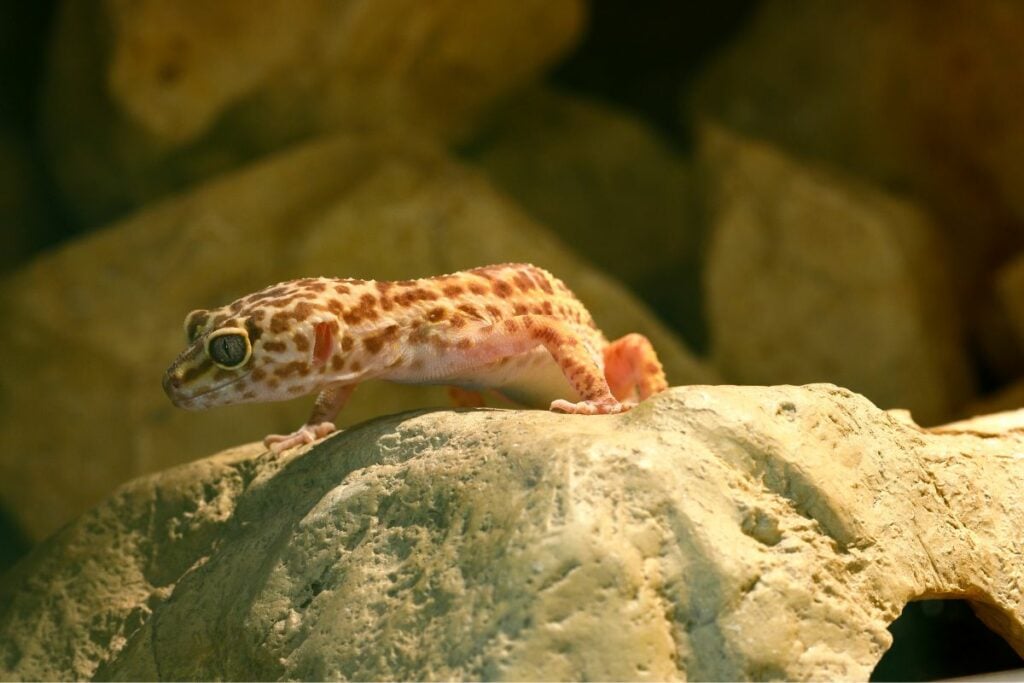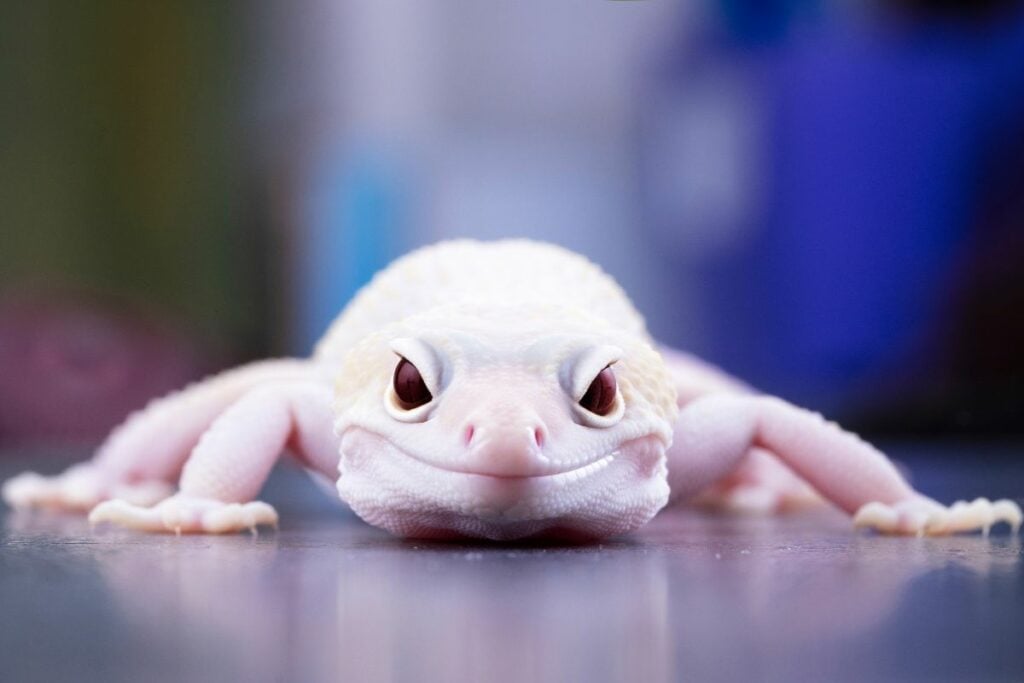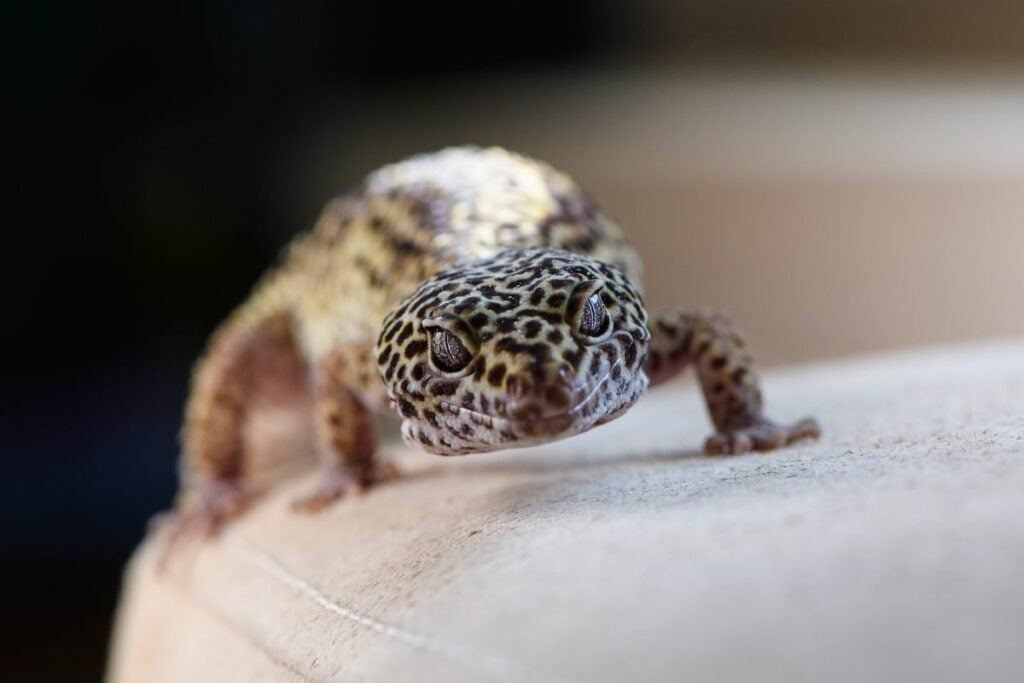Leopard geckos are fascinating and adorable creatures that have become increasingly popular as pets over the years.
These reptiles are native to the deserts of Afghanistan, Pakistan, and parts of India and have adapted to life in hot and dry environments. As such, they require specific care and attention to thrive in captivity.

One of the most critical aspects of caring for leopard geckos is ensuring they have the right temperature in their habitat.
Reptiles are cold-blooded, which means they rely on external sources of heat to regulate their body temperature. Without adequate warmth, they can become lethargic, lose their appetite, and may even become sick.
So, do leopard geckos need a heat lamp? This is a question many new pet owners ask, and the answer is a resounding yes.
Heat lamps are essential for providing the necessary warmth that these reptiles need to stay healthy and happy.
However, it’s not just a matter of turning on a lamp and letting it run all day. Understanding their temperature needs, environment, and care is crucial to ensure they thrive in captivity.
In this article, we’ll delve deeper into the topic of leopard geckos and heat lamps. We’ll explore why they need heat, how to set up their habitat correctly, and what other factors are essential to keep them healthy and happy.
Whether you’re a first-time pet owner or a seasoned reptile enthusiast, this guide will provide you with the information you need to care for your leopard gecko properly (see also “Leopard Gecko Gender Guide“).
Quick Answer: Do Leopard Geckos Need A Heat Lamp?
Although many people believe that they are able to survive without one, the reality is that leopard geckos do need a heat lamp.
As cold-blooded animals, they require external sources of heat to regulate their body temperature, and a heat lamp provides the necessary warmth for their well-being.
Without adequate warmth, leopard geckos may become lethargic, lose their appetite, and may even become sick.
However, it’s important to note that simply providing a heat lamp is not enough. You must ensure that the heat lamp is set up correctly, and the temperature in the leopard gecko’s habitat is within the appropriate range.
Leopard geckos require a temperature gradient in their habitat, with a warm basking area and a cooler area to regulate their body temperature as needed.
In addition to a heat lamp, leopard geckos also require access to UVB lighting, a suitable substrate, hiding places, and a balanced diet.
Providing a proper habitat that mimics their natural environment is crucial to keep them healthy and happy.
If you’re considering getting a leopard gecko as a pet, it’s essential to do your research and understand their needs before bringing one home.
By providing them with a suitable habitat, including a heat lamp, you can ensure that they thrive!
Why Do Leopard Geckos Need A Heat Lamp?
As mentioned before, leopard geckos require a heat lamp in their tank as standard, and there’s a good reason for this too.
Unlike mammals (like humans), lizards are reptiles, and have colder blood, which is also known as being ectothermic.
As mammals, our warm-blood makes us much better at adapting to cold temperatures and climates as we can generate heat from our bodies.
Unfortunately lizards, including leopard geckos, are unable to do so, which is why it is so important that they have access to external heat sources.
When living in the wild, leopard geckos are able to get plenty of heat from both the sun, and from the ambient temperature of their environment, which is a combination of the temperature of the air, and the ground, all thanks to the sun.
The heat they get from both of these sources are critical to their daily functions, and they rely on the heat to do things such as: food digestion, excreting waste, energy for movement and reproduction, breathing, and regulating their daily habits.
In captivity, many people use a heat mat to help provide an external heat source for their leopard geckos, but on top of that, it’s also recommended that you invest in an adequate heat lamp, which will allow you to create a “hot zone” inside of your gecko’s tank, which will help to simulate their natural environment, and allow your gecko to thrive.
As well as being an external heat source, having a heat lamp will also allow you to imitate a day/night cycle within your leopard gecko’s tank, just as they would experience in the wild, which is another important aspect of keeping your gecko happy and healthy.
Can A Leopard Gecko Use Just A Heat Mat Instead?

While a heat mat is an important component of a leopard gecko’s enclosure, it is not sufficient on its own for their survival.
Leopard geckos require a range of environmental conditions to thrive, including appropriate temperature gradients, humidity levels, and lighting.
In addition to a heat mat, leopard geckos need a source of UVB lighting to help them properly metabolize calcium, which is essential for their bone health.
They also need a suitable substrate for burrowing, appropriate hide boxes for thermoregulation and stress reduction, and a varied diet of appropriately sized insects.
Therefore, it is not recommended to rely solely on a heat mat for a leopard gecko’s survival. A properly set up and maintained enclosure with all necessary components is crucial for their health and well-being.
If I Live In A Warm Enough Climate, Does My Leopard Gecko Still Need A Heat Lamp?
Although you might think living in a warm environment will be enough to keep your leopard gecko happy, the reality is that you’ll still need a sufficient heat source in order for your leopard gecko to thrive and be healthy.
This is down to the fact that if the tank that you keep your leopard gecko in is kept inside a room in your house, you will be unable to simulate a day-night cycle properly.
In addition to this, a room is also particularly susceptible to frequently changes in air pressure too, and it’s these regular changes that can lead to air drafts, which will cool the room down from its current ambient temperature.
This changing of temperature is unhealthy for your leopard gecko, and makes them much more likely to fall ill, even if the temperature falls for a short period of time.
Even if you live in a warm climate, you should still ensure that your leopard gecko is provided with a heat mat and lamp, providing that you regularly monitor the temperature of the tank.
However, it’s also important to note that if you live in a warmer climate, it’s completely possible for your leopard gecko (see also “Complete Leopard Gecko Poop Guide“) to overheat too, which is why it’s so important to frequently monitor the temperature of your leopard gecko’s tank, and why the temperature gradient of the tank is vitally important too!
What Are Temperature Gradients?
One of the most important aspects of leopard gecko ownership is ensuring that you create an adequate temperature gradient inside the tank of your leopard gecko.
These cold-blooded animals will seek out a variety of different temperatures throughout the course of the day, which is why it’s so essential to ensure that your tank is able to provide this variety of temperatures.
The temperature gradient simply refers to the difference in temperature between the coldest part of the tank, and the hottest.
The hottest part of the tank is usually where you would tend to set up your heat lamp and basking area for your leopard gecko, and the coldest part of the tank tends to consist of a shaded area, where the ground is much cooler for your leopard gecko.
Leopard geckos aren’t overly fond of the sunshine or basking, and won’t bask under a heat lamp directly very often, but it is important to ensure that they have the option to do so when they want to.
This hot light and area of the thank will make the shaded area of the tank even more appealing to your leopard gecko, and will help to simulate a similar use of environment as your leopard gecko would in the wild.
Probably the only time your leopard gecko will utilize this hot basking spot is when it is feeling ill or unwell, and needs to increase its metabolism, which it can do by increasing its body temperature.
Whereas it will spend most of its time in the cooler, more shaded areas of its tank, where it can hide and cool off.
What Happens To Leopard Geckos Without A Heat Lamp?
What many people don’t realize about leopard geckos, especially prospective first time owners, is that an adequate amount of heat is required for your leopard gecko to even survive, and there can be some particularly adverse effects if your leopard goes without enough heat for too long.
If the temperature in the tank drops below 15 degrees celsius, or 60 degrees fahrenheit, then within just a couple of days your leopard gecko can die, which as an owner, is the last thing you want to happen.
However, just because the temperature in the tank is above this, does not mean that your leopard gecko is going to be fine without a number of external heat sources, and the absence of heat lamp and heat map, which are used to help simulate the night and day temperature cycle, then your leopard gecko can die within a month.
They can also die much sooner than this if they’re also experiencing other stressors too, such as an underlying illness, inadequate diet, competiton with another gecko for food, age, and of course, no other heat sources.
Although a lack of external heat sources can be a major problem for your leopard gecko, so can having failing or poor heating equipment, and if the tank of your leopard gecko is off by even a degree or two, then your leopard gecko can quickly fall ill.
You can prevent this by ensuring that all of the equipment in your leopard gecko’s tank is set up as per the manufacturer’s instructions, and if you can’t see anything wrong with the heating in your leopard gecko’s tank, then try to look out for your leopard gecko displaying some of the common signs of inadequate heating in the tank, which include:
- Lethargy and tiredness
- Trouble opening its eyelids
- Tendency to hide away more than it should
- Bad drinking or feeding habits
If you notice any of these changes occurring with your leopard gecko, then it’s vital that you check the thermometer, and the tank’s hygrometer to ensure that the tank is both warm enough whether or not it requires any misting.
As such then, it’s super important to ensure that you have the adequate heating equipment to keep your leopard gecko happy and health in your care.
How To Heat Your Leopard Gecko’s Tank Correctly

So far then, ensuring that your leopard gecko’s tank is the correct temperature and has a suitable temperature gradient sounds like a stressful task. In reality, it’s much simpler than you think, so long as it’s done correctly.
To ensure that your leopard gecko is living in a tank environment that is going to allow it to live happily and healthily, then you’ll need to create a proper temperature gradient in the tank, which will allow you to simulate the natural day and night cycle your leopard gecko would usually experience.
During the day, in the hot zone of your leopard gecko’s tank, the temperature should be somewhere between 28 to 35 degrees celsius, or 82.4 to 95 degrees fahrenheit. Whereas the cool zone of your leopard gecko’s tank should be around 24 to 26 degrees celsius, which is between 75.2 and 78.8 degrees fahrenheit.
At night, your leopard gecko’s tank should be no colder than 18 degrees celsius, which is 64.4 degrees fahrenheit, no matter which zone it is.
It’s important to memorize these temperatures, and perhaps even keep them as a note near the location of your leopard gecko’s tank in your home, which means that you will be able to regularly monitor the temperature on the thermometer against these temperatures.
Creating The Day And Night Cycle
Having to create the day and night cycle that your leopard gecko would experience in the wild is one of the most important parts of leopard gecko ownership, because just like most animals in the world (including us humans), leopard geckos have learned to behave differently during the colder temperatures at night than they do in the warmer temperatures of the day time.
People will often mention that leopard geckos are nocturnal, which is actually untrue. Instead, these lizards are actually crepuscular, which means that they are predominantly active at twilight!
This is why it’s so important for your leopard gecko to experience a range of temperatures throughout the day, as this is how your leopard gecko will be able to tell when it should be more active, and use more energy, as well as when it should be resting.
In order to do this, all you need to do is to turn on the heat lamp in your leopard gecko’s tank for a specific amount of time each day, and at specific points in each day, which will help to emulate the sunlight.
This heat lamp can also be used in conjunction with an adequate 2-7% UVB light which should be kept between 9 to 12 inches above the highest point in which your leopard gecko is able to bask.
You should also try to mount the UVB light to the back of the ceiling towards the hot zone, allowing you to create a UVB gradient in conjunction with the heat gradient.
In the summer, your gecko should receive 12 hours of daylight hours, and 10 hours of night time hours. Whereas in the winter, your gecko should receive 10 hours of daylight hours, and 14 nighttime hours.
During the spring and the fall, you should ensure that you slowly transition between the amount of daylight and nighttime hours your gecko experiences at a pace of 20 minutes a week, which will ensure that you don’t stress your leopard gecko out.
Final Thoughts
Overall, ensuring that your leopard gecko is getting the right amount of heat is extremely important, but so long as you set up the right heating equipment, which includes a heat lamp, in your leopard gecko’s tank as per the manufacturer’s instructions, you’ll be able to keep your cold-blooded friend happy and healthy throughout their life!
There are many great heat lamps out there, and if you need help picking the right one for your leopard gecko’s tank, then just consult someone in your local pet store, or wherever you bought your leopard gecko from, and they should be able to point you in the right direction (see also “Crucial Symptoms That Show That Your Leopard Gecko Is Dying And What To Do About It“).
- Can Leopard Geckos Eat Silkworms? - March 11, 2024
- Do Leopard Geckos Climb? - March 4, 2024
- Do Leopard Geckos Bask? The Answer Will Surprise You - February 21, 2024
